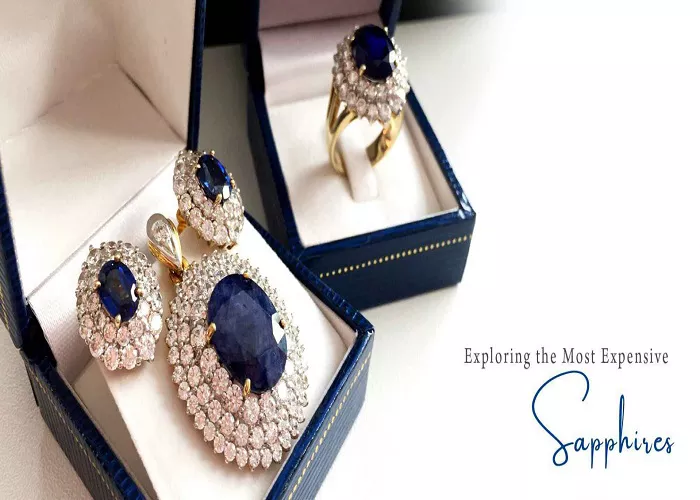Blue sapphire is one of the most sought-after gemstones in the world. Its deep, rich color and exceptional durability make it highly desirable for fine jewelry. But why is blue sapphire so expensive? The answer lies in its rarity, quality factors, mining conditions, and market demand.
In this article, we will explore:
- What Makes Blue Sapphire Special?
- Factors That Determine Its Value
- Mining and Sources
- Treatments and Enhancements
- Market Demand and Famous Blue Sapphires
- Investment Potential
By the end, you will understand why this gemstone commands such high prices.
1. What Makes Blue Sapphire Special?
Blue sapphire belongs to the corundum mineral family, which also includes ruby. While rubies are red due to chromium, blue sapphires get their color from iron and titanium.
Key Features of Blue Sapphire:
- Hardness: 9 on the Mohs scale (second only to diamond).
- Durability: Resistant to scratches, ideal for everyday wear.
- Color Range: From light blue to deep royal blue.
- Symbolism: Represents wisdom, royalty, and divine favor.
Because of these qualities, blue sapphire is a favorite for engagement rings, royal jewelry, and high-end collections.
2. Factors That Determine Blue Sapphire’s Value
Several factors influence the price of blue sapphire. The most important are:
Color
Color is the most critical factor in pricing. The finest blue sapphires have:
- Vivid, medium to dark blue tone (not too light or too dark).
- Strong saturation (intense color).
- No unwanted tints (green or gray reduces value).
The most prized shade is “Cornflower Blue” (like the Kashmir sapphire) or “Royal Blue” (deep, velvety blue).
Clarity
Unlike diamonds, sapphires often have inclusions (internal flaws). However:
- Eye-clean sapphires (no visible flaws) are rare and expensive.
- Minor inclusions are acceptable if they don’t affect brilliance.
- Silk inclusions (fine needle-like rutile) can enhance value by creating a velvety glow (as in Kashmir sapphires).
Cut
A good cut maximizes color and brilliance. Common cuts:
- Oval, Cushion, Round (most popular for rings).
- Emerald, Princess (for a modern look).
- Cabochon (domed cut, often used for star sapphires).
Poor cuts can make the stone look dull or uneven.
Carat Weight
Larger sapphires are exponentially rarer, so prices rise sharply with size:
- 1-2 carats: More common, moderately priced.
- 3-5 carats: Rare, expensive.
- 10+ carats: Extremely rare, auction-worthy.
Origin (Mining Source)
Some locations produce the best blue sapphires:
- Kashmir (India): The rarest, most valuable (known for velvety blue).
- Burmese (Myanmar): Rich, royal blue hues.
- Ceylon (Sri Lanka): Bright, medium blue (most commercial supply).
- Madagascar: Newer source with high-quality stones.
- Montana (USA): Unique steel-blue shades.
Kashmir sapphires can fetch millions per carat at auctions due to limited supply.
3. Mining and Sources: Why Is Supply Limited?
Kashmir Sapphires: The Rarest of All
- Discovered in 1881 in the Himalayas.
- Mined for only 10 years before depletion.
- Known for “cornflower blue” with a soft glow.
- Almost no new stones enter the market, making them auction stars.
Burmese Sapphires
- Mined in Mogok Valley (same region as rubies).
- High chromium content gives a deep blue with violet hints.
- Political issues in Myanmar restrict supply.
Ceylon (Sri Lankan) Sapphires
- Largest commercial source.
- Known for bright, lighter blue tones.
- Still expensive, but more available than Kashmir/Burmese.
Madagascar Sapphires
- Discovered in the 1990s, now a major supplier.
- Quality rivals Ceylon stones.
- More affordable than Kashmir but rising in price.
Other Sources
- Montana (USA): Small supply, unique color.
- Australia, Thailand, Cambodia: Often darker, less valuable.
Mining Challenges
- Sapphires are found in alluvial deposits (riverbeds) or hard rock.
- Labor-intensive extraction increases costs.
- Political and environmental regulations limit production.
4. Treatments and Enhancements: How They Affect Price
Most blue sapphires are treated to improve color and clarity.
Heat Treatment (Most Common)
- Purpose: Enhances color, removes impurities.
- Acceptance: Widely accepted if disclosed.
- Price Impact: Heated sapphires cost 30-50% less than untreated ones.
Diffusion Treatment
- Purpose: Adds color by infusing elements (e.g., titanium).
- Acceptance: Considered lower quality.
- Price Impact: Much cheaper than natural stones.
Untreated Sapphires
- Extremely rare (only about 5% of the market).
- Command premium prices (up to double or more).
- Certification required (GIA, AGL, SSEF).
5. Market Demand and Famous Blue Sapphires
Celebrity and Royal Influence
- Princess Diana’s Engagement Ring (now worn by Kate Middleton) features a 12-carat Ceylon sapphire.
- Elizabeth Taylor’s sapphire necklace sold for millions.
- Beyoncé, Penélope Cruz, and Victoria Beckham own high-profile sapphire jewelry.
Auction Records
- The Rockefeller Sapphire (62.02 carats): Sold for $3 million in 2001.
- The Blue Belle of Asia (392.52 carats): Sold for $17.3 million in 2014.
- Kashmir sapphires regularly sell for $100,000+ per carat.
Engagement Ring Trend
- After Prince William proposed with Diana’s ring, sapphire engagement rings surged in popularity.
- Seen as a unique, luxurious alternative to diamonds.
6. Is Blue Sapphire a Good Investment?
Pros:
- Rarity increases value over time (especially Kashmir/Burmese).
- Durable (won’t scratch or break easily).
- High demand from collectors and jewelry lovers.
Cons:
- Prices fluctuate based on origin and treatments.
- Requires certification to prove authenticity.
- Not as liquid as diamonds (harder to resell quickly).
Best for long-term investors who buy top-quality, untreated stones.
Conclusion
Blue sapphire’s high price comes from:
- Rarity (especially Kashmir and untreated stones).
- Exceptional color and brilliance.
- Limited mining supply.
- High demand from royalty and celebrities.
- Investment potential for top-quality gems.
If you want a timeless, valuable gemstone, blue sapphire is an excellent choice—but be prepared to pay a premium for the best quality.
Would you like help selecting a blue sapphire? Consult a certified gemologist to ensure you get the best value.
Related Topics:
- Why Blue Sapphire is So Expensive?
- Opal vs. Tourmaline: Which is the More Expensive Gemstone?
- Why Is Watermelon Tourmaline So Expensive?


